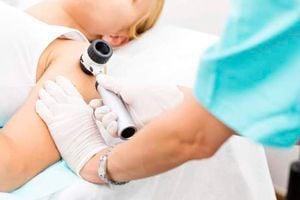How do I know I have a skin cancer?
)
Skin cancers are usually noticed by the patient's themselves, or sometimes by their relatives. The usual symptoms are:
- Sores that don't heal and keeps breaking open
- Scaly scabs that fall off and reform continually
- Growing lump or nodule on the skin
- Spots that bleed recurrently with very little trauma (e.g. towelling after shower, shaving, or rubbing)
- A pink or dark spot that has suddenly appeared and increasing in size
- A mole that has changed colour, shape or size
Regular skin checks by either your GP or dermatologist is also recommended every 12 months; this should be increased to 6 months if you have a history of skin cancers. Skin checks are important as the doctor check areas where you are unable to monitor yourself, such as your back, scalp, behind your ears and the back of your legs.
The treatment of skin cancers depend on the type, site, size and depth. A biopsy (test sample) is the best way to obtain a diagnosis, and allows optimal planning of the best treatment plan. It can also differentiate between a benign skin growth versus a cancerous lesion. Not all skin cancers require surgery. In turn, some skin cancers can only be adequately treated with surgical resection.Just remember, if you are in doubt, get it checked out!
To read more about skin cancers, click here) Author:Dr Lily Vrtik
Author:Dr Lily Vrtik| Tags:Skin CancersSkin |

